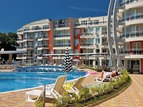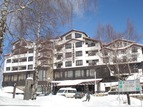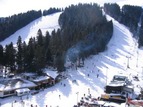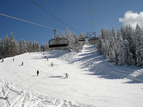Zemen Monastery keeps unique medieval frescos
bnr.bg, 28.06.2011
 Some 70 km to the southwest of Sofia near the town of Zemen, stands a beautiful monastery. Behind its heavy gates spreads a large green yard lined with huge trees. The yard’s center is dominated by a sophisticated small church. Its age is venerable – it was built about one thousand years ago, in 11 c. The complex also includes a bell tower and a long two-storey building, a replica of the old structure with the monastic cells. We are lucky to have come on Monday. The place is crowded on weekends, and now it is charmingly calm.
Some 70 km to the southwest of Sofia near the town of Zemen, stands a beautiful monastery. Behind its heavy gates spreads a large green yard lined with huge trees. The yard’s center is dominated by a sophisticated small church. Its age is venerable – it was built about one thousand years ago, in 11 c. The complex also includes a bell tower and a long two-storey building, a replica of the old structure with the monastic cells. We are lucky to have come on Monday. The place is crowded on weekends, and now it is charmingly calm.
“This is one of the oldest churches in Bulgaria surviving without the menace of destruction or fire”, the guide at the complex Kamelia Stoyancheva says. “The church – a national monument of culture – is named after St. John the Evangelist. Its first frescoes were created in 11 c. One of them depicts the scene of forging the nails for the Crucifix. This scene is found only in our church. One of the blacksmiths in this scene is a woman. Why? Legend has it that when one of the blacksmiths was asked to forge the nails for the Crucifix of Jesus Christ, he turned the demand down by saying that his arm hurt. He lied but later it did hurt. So, instead of him his wife went to hammer the nails. Another remarkable fresco painted in an unconventional way, is the scene The Sacrament of the Apostles. It is known that Christ gave bread to the apostles with one hand, and wine – with the other. Here, the unknown and very talented artist depicted Christ twice and divided the apostles into two groups. Christ No. 1 gives bread to one of the groups, and Christ No. 2 gives wine to the other. Well, these are indeed unique frescoes.”
Another unique fresco at Zemen Monastery is of The Assumption painted on the western side of the church. “The scene itself is quite beautiful”, Kamelia Stoyancheva says further. “In it Christ holds above His mother’s deathbed a small creature covered in white – the soul of Virgin Mary.” Other frescoes portray saints, evangelical scenes and the monastery’s key benefactors. They reveal the talent of the medieval artist who painted the church interiors. Both the stone altar and the floor are impressive.
“The sensation of stepping on slabs 10 centuries old is incredible”, guide Kamelia Stoyancheva says further. “So many generations have stepped on them. The floor combines various kinds of stones – marble pieces in different colors and shapes. In 11 c. when the church was built the locals wanted to bring their own stones to leave something that time could not harm. So one can see today bigger slabs, medium-sized stones and even cobbles. This makes the floor so diverse and colorful. The stone altar has survived since the church’s founding.” As to the monastery complex it has collapsed on several occasions and was repeatedly rebuilt. Until 1966 there were monks here. The new building was completed two years ago and is a replica of the original monastery structure. The Zemen Monastery has been a subsidiary of the National Museum of History since 2003. “I love my job so much, because both Bulgarians and foreigners come over here: people who value history and art. And they leave the monastery satisfied – there are things worth seeing”, Kamelia Stoyancheva concludes.
 Member of:
Member of:



























 Touroperator
Touroperator
